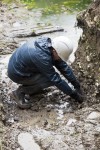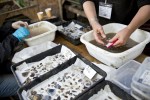 University of Buckingham archaeologists excavating the Mesolithic site of Blick Mead near Amesbury, Wiltshire, just over a mile from Stonehenge, have found the charred leg bone of a toad along with the bones of other animals feasted upon between 6250 and 7596 B.C. This is the earliest evidence of cooked frogs’ legs ever discovered, pre-dating French examples by 8,000 years and throwing a beloved ethnic slur into turmoil.
University of Buckingham archaeologists excavating the Mesolithic site of Blick Mead near Amesbury, Wiltshire, just over a mile from Stonehenge, have found the charred leg bone of a toad along with the bones of other animals feasted upon between 6250 and 7596 B.C. This is the earliest evidence of cooked frogs’ legs ever discovered, pre-dating French examples by 8,000 years and throwing a beloved ethnic slur into turmoil.
 Excavations at the Blick Mead site have been ongoing since 2005. Beginning in May 2010, a large number of flint pieces and animal bones dating to the Mesolithic era were discovered. In three trenches, one 20 x 13 feet in size, the other two just six and a half feet square, archaeologists unearthed 12,000 pieces of worked and burned flint, plus more than 650 bone fragments. The flint tools were in exceptional condition, some of them so sharp they actually cut the fingers of the archaeologists who discovered them. The burned pieces are evidence of very large and hot fires built on or very near this site.
Excavations at the Blick Mead site have been ongoing since 2005. Beginning in May 2010, a large number of flint pieces and animal bones dating to the Mesolithic era were discovered. In three trenches, one 20 x 13 feet in size, the other two just six and a half feet square, archaeologists unearthed 12,000 pieces of worked and burned flint, plus more than 650 bone fragments. The flint tools were in exceptional condition, some of them so sharp they actually cut the fingers of the archaeologists who discovered them. The burned pieces are evidence of very large and hot fires built on or very near this site.
 Last year researchers examined the bones. They found that a large majority of them, more than 60%, were aurochs bones. Aurochs were large wild cattle which ones roamed the forests of Europe. Highly prized by hunters, they were extinct in England by 2,000 B.C. Their size and fierceness made them quarries as desirable as they were formidable, and they probably held symbolic significance in Mesolithic society, hence the large percentage of aurochs remains in Blick Mead. The bones of other large animals were identified as well, among them an unusually large red deer and wild pig.
Last year researchers examined the bones. They found that a large majority of them, more than 60%, were aurochs bones. Aurochs were large wild cattle which ones roamed the forests of Europe. Highly prized by hunters, they were extinct in England by 2,000 B.C. Their size and fierceness made them quarries as desirable as they were formidable, and they probably held symbolic significance in Mesolithic society, hence the large percentage of aurochs remains in Blick Mead. The bones of other large animals were identified as well, among them an unusually large red deer and wild pig.
It’s a little bone that is making the big splash today, though: the tiny humerus of a toad.
David Jacques, senior research fellow in archaeology, said: “It would appear that thousands of years ago people were eating a Heston Blumenthal-style menu on this site, one-and-a-quarter miles from Stonehenge, consisting of toads’ legs, aurochs, wild boar and red deer with hazelnuts for main, another course of salmon and trout and finishing off with blackberries.
“This is significant for our understanding of the way people were living around 5,000 years before the building of Stonehenge and it begs the question – where are the frogs now?”
 Blick Mead’s close proximity to Stonehenge and Bluehenge makes it of particular interest to archaeologists investigating the origin of Stonehenge, its Mesolithic context, why it was built on the Salisbury Plain, what the religious significance of the area may have been before the first ditch was dug. Radiocarbon dating of Mesolithic remains found that the site was occupied every millennium between 7550 and 4700 B.C. That’s 3,000 years of if not continuous use, regular use and reuse. It’s what is known as a “homebase,” a Mesolithic residential site revisited repeatedly over time. This is the oldest place of residence found in the Stonehenge area.
Blick Mead’s close proximity to Stonehenge and Bluehenge makes it of particular interest to archaeologists investigating the origin of Stonehenge, its Mesolithic context, why it was built on the Salisbury Plain, what the religious significance of the area may have been before the first ditch was dug. Radiocarbon dating of Mesolithic remains found that the site was occupied every millennium between 7550 and 4700 B.C. That’s 3,000 years of if not continuous use, regular use and reuse. It’s what is known as a “homebase,” a Mesolithic residential site revisited repeatedly over time. This is the oldest place of residence found in the Stonehenge area.
It’s also a contemporary of the only other Mesolithic discovery in the Stonehenge environs: four, perhaps five (one might be the result of a tree falling accident) Mesolithic postholes found underneath the visitor parking lot in the 1960s. They date to approximately the same time as the frog humerus and other bones, ca. 7,500 B.C., and both Mesolithic sites are just over a mile from each other. Perhaps knowledge of these ritually significant spots was passed down through the generations over the site’s 3,000 years of use, cementing its religious symbolism so firmly that it outlasted the transition from Mesolithic to Neolithic and inspired the builders of Stonehenge around 3000 B.C.
One possible element of ritual meaning might be the natural springs in the area. The flint and bones were found where once burbled a constant-temperature spring. Bluehenge also has a spring adjacent to it. There are Bronze Age weapons deposits that suggest the Blick Mead spring continued to hold specific religious meaning in 1,400 B.C. and artifacts from the Anglo-Saxon era and 10th-11th century Amesbury Abbey period point to a continuing ritual significance of the area even when the rituals changed enormously.
Andy Rhind-Tutt, chairman of Amesbury Museum and Heritage Trust and co-ordinator of the community involvement on the dig, said …: “No one would have built Stonehenge without there being something unique and really special about the area. There must have been something significant here beforehand and Blick Mead, with its constant temperature spring sitting alongside the River Avon, may well be it.
“I believe that as we uncover more about the site over the coming days and weeks, we will discover it to be the greatest, oldest and most significant mesolithic home base ever found in Britain.”
“Currently Thatcham – 40 miles from Amesbury – is proving to be the oldest continuous settlement in the UK with Amesbury 104 years younger. By the end of this latest dig, I am sure the records will need to be altered.”
The frog was obviously eaten by a French tourist, though prepared by an English inn-keeper, ever famous for their skilled cuisine and willing to put themselves out for visitors.